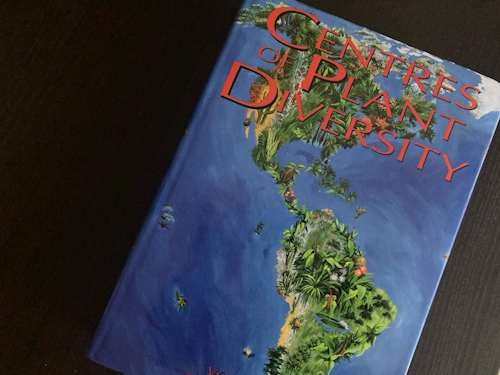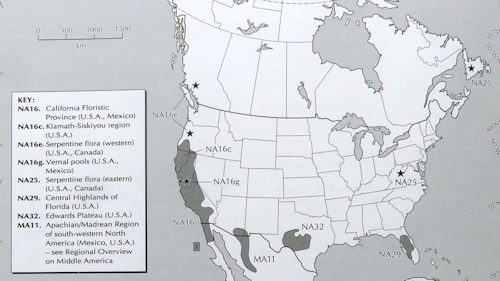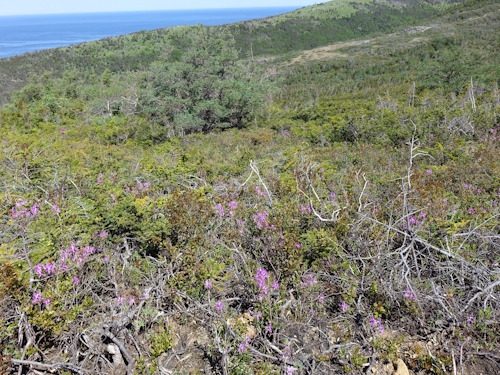Blog Connections
Centres of Plant Diversity #2
Plant WHS may not be everyone’s cup of tea, but since my blog post from a month ago Solivagant and I have deep-dived into the Centres of Plant Diversity (CPDs). We got access to the full list and mapped the WHS to CPDs, resulting in two new connections. And, as always with exercises like this, we also learned some other things about WHS and the WH process along the way.

The Books
After a short exploration of the topic on our Forum, it became clear quickly that we could not finish this without having access to at least one (and possibly all three) of the CPD books. These are generally sold new at high prices (60-100 EUR each), but cheaper copies can be bought from online second-hand bookstores. I got Volume 3 (Americas) and Solivagant acquired the whole set including the other continents. It turned out that we needed the full set, as each volume only lists the CPD in its geographical region.
If you’re into encyclopedic specialist works, you might like to have these CPD books in your collection. Each volume is a large hardcover of up to 600 pages, including maps and black-and-white photographs. However, working with them for a few weeks for our purposes, serious flaws came to light as well. Mostly because the work feels incomplete and unfinished – less than half of the CPDs have a usable description. Maybe the project by IUCN and WWF was overambitious from the start, which also could be the reason that no updates have ever been planned. Having been compiled in 1994, they are now outdated as since then many new floral inventories have been done, especially at national parks that came into existence later.
The List of CPDs
It turns out that there are not 234 CPDs, as quoted in several sources including Wikipedia, but 490. The confusion lies in the fact that out of the 490, only 234 are fully described in so-called datasheets and are displayed on the maps in the book. However, the others are identified as well with unique IDs, and each has a short introduction text; they are equally important as the others. Especially for Africa and China, the coverage by full datasheets is low.
Some of the CPDs cover a very large area, such as Central Anatolia and the California Floristic Province (see map below).

Mapping them to WHS
We started the mapping process with a spreadsheet containing all the natural WHS that are inscribed on criteria 7, 9, or 10. As criterion 8 is for geological sites we deemed it irrelevant for this cause. By region and country, we then tried to place the WHS within a CPD, a rather time-consuming task as the texts generally do not reference WHS and – as stated above – over 50% of the CPDs are hardly described or displayed on maps. For those we mostly had to rely on the CPD names plus the state/province they are in. Some WHS for this reason were impossible to map; Kaeng Krachan Forest for example is labelled as being in a CPD in its AB evaluation, but we found no sure match (it could be part of ‘EA58 Limestone flora’ but who knows?).
The mapping led us to the following main conclusions:
- Not all WHS with plant diversity OUV are part of a CPD - we've found another 35 that could easily be in there. We only selected the WHS inscribed on Criterion X (biodiversity) and clearly described plant value. Central Suriname Nature Reserve, Coiba NP, Guanacaste, Lopé-Okanda and Noel Kempff Mercado NP seem the most glaring omissions.
- IUCN puts way too much worth into the CPD listing – IUCN in its evaluations somewhat routinely refers to a site ‘being in a CPD’, without relating it to specific plant value. They‘d better reuse the criteria (such as “holds over 1,000 plant species”) instead of this outdated inventory.
- Criterion X is not always used where it should have been – Some sites, such as Pirin NP and the Hyrcanian Forests, that have only criterion 7 or 9, are clear examples of a CPD. While criterion X was never discussed for Pirin NP (despite the comparative analysis concluding “an extremely rich flora which cannot be matched anywhere else" [in Central and Northern Europe]), it was for the Hyrcanian Forests but IUCN requested an inventory per component of this serial site and I guess Iran/Azerbaijan refused the work and accepted inscription on criterion IX only.
- Unrepresented CPDs may identify Natural Gaps on the WH List - most CPDs aren’t represented by a WHS at all. Northern Canada for example has 9 CPDs, but none match a WHS with plant OUV. For example, IUCN found Gros Morne NP (photo 3) representing "about 60% of Newfoundland's flora" but it was not inscribed for its biodiversity. Especially notable is the case of Papua New Guinea, which has no less than 39 separate CPDs but no (natural) plant-related WHS at all! On its Tentative List though linger Kikori River Basin (3 CPDs), Trans-Fly Complex (1 CPD) and Upper Sepik River (3 CPD).
Additionally, we found Table 6 in this IUCN publication about possible future natural WHS based on biodiversity not too reliable. They seem to have mapped the WHS based on geographical coordinates only, which have the hoodoos of Göreme and the fossils of Miquasha being placed in a CPD while they have no plant OUV whatsoever. This is partly caused by the very large size of some CPDs: following this logic it could also be said that cities like Izmir and Los Angeles are in a CPD.

Connection(s)
We ended up with two connections: one with WHS with plant-related OUV that are part of a CPD, and one with WHS that have Criteria X, clear plant-diversity OUV, and are NOT in a CPD. The first has 95 connected WHS, the latter has 35 WHS. The two combined provide the best overview of WHS that derive their value from biodiversity based on plants and trees.
Some WHS are even spread across 2 CPDs, such as Manu NP, Discovery Coast, Sichuan Giant Panda Sanctuaries, Three Parallel Rivers of Yunnan and the Tropical Rainforest of Sumatra.
Several CPDs are represented by multiple WHS. The Mountains of Middle Asia (Tajik National Park, Tugay Forests, Western Tien-Shan), the Eastern slopes of Peruvian Andes (Machu Picchu, Manu NP, Rio Abiseo) and the Sonoran Desert (El Pinacate, Gulf of California, El Vizcaino) each have more than two.
If you have remarks or want more info about WHS and CPDs, please use the Forum post.
Els - 14 April 2024
Comments
Kyle Magnuson 14 April 2024
Just for clarification and a little pride. Los Angeles has the San Gabriel Mountains National Monument and the Santa Monica Mountains National Recreation Area, together more than 600,000 Acres (and growing) of protected lands (243,000 Hectares). I know of only a few major cities around the World with that kind of protected lands in its backyard! The Santa Monica National Recreation Area is often cited as the largest urban national park in the World.